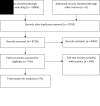Aetiology of diarrhoea in children aged zero to nine years in low- and middle-income countries: A systematic review
- PMID: 39485019
- PMCID: PMC11529147
- DOI: 10.7189/jogh.14.04168
Aetiology of diarrhoea in children aged zero to nine years in low- and middle-income countries: A systematic review
Abstract
Background: While diarrhoeal disease remains a leading cause of death in children aged <5 years in low- and middle-income countries (LMICs), it also poses significant health risks for older children, underscoring the importance of our study focusing on children aged <10 years. In this systematic review, we assessed common diarrhoea aetiologies in children aged <10 years in LMICs.
Methods: We identified relevant articles in PubMed, Embase, and Web of Science using pre-defined search criteria. We included case series and case-control studies of children aged <10 years with non-bloody, bloody, acute, persistent, and chronic diarrhoea. Articles that evaluated two or more diarrhoea pathogens in LMICs conducted between 1 January 1990 and 31 July 2020 were eligible for inclusion. We stratified combined data from case series and case-control studies by age and World Health Organization (WHO) regions.
Results: 76 studies published between 1990-2020 were eligible for inclusion. Among these, eight were case-control studies. 56 papers focused only on children aged <5 years, while 20 also included children aged ≥5 years. The most common viral pathogens among <5 years old children were rotavirus, norovirus, adenovirus, and astrovirus. Bacterial pathogens included Escherichia coli, Salmonella enterica, Shigella species, and Campylobacter species, while parasitic pathogens included Cryptosporidium, Giardia, and Entamoeba species. Rotavirus was the most common viral pathogen among children across all age groups and every WHO region. Escherichia coli was prevalent in all age groups and was responsible for most diarrhoea cases in the African Region. Among parasitic pathogens, Entamoeba species and Giardia were prevalent in children aged three to five years, with the former a major cause of diarrhoea in the Eastern Mediterranean Region. Similarly, in children aged six to 10 years, bacterial pathogens, including Escherichia coli, Salmonella, and Shigella, suggest a continued significance of these pathogens beyond the age of five. Common viral pathogens for this group were rotavirus, norovirus, and sapovirus, although the number of studies for this age group is limited.
Conclusions: Escherichia coli, rotavirus, and Entamoeba species were the most common pathogens responsible for diarrhoea in children aged <5 years in LMICs. Future research should focus on characterising the pathogens responsible for causing diarrhoea in children aged six to 10 years stratified by geographic area of residence, i.e. WHO region and urban vs rural. Case-control or cohort studies covering a full 12-month period to account for seasonality are needed for a more accurate picture of diarrhoea aetiology among children.
Registration: PROSPERO (CRD42020204005).
Copyright © 2024 by the Journal of Global Health. All rights reserved.
Conflict of interest statement
Disclosure of interest: The authors have completed the ICMJE Disclosure of Interest Form (available upon request from the corresponding author) and declare the following activities and relationships: YBN is a staff member of the WHO.
Figures







References
-
- Villavicencio F, Perin J, Eilerts-Spinelli H, Yeung D, Prieto-Merino D, Hug L, et al. Global, regional, and national causes of death in children and adolescents younger than 20 years: an open data portal with estimates for 2000–21. Lancet Glob Health. 2024;12:e16-7. 10.1016/S2214-109X(23)00496-5 - DOI - PubMed
-
- United Nations Inter-agency Group for Child Mortality Estimation. Cases of deaths: rates in under 5 years. 2024. Available: https://childmortality.org/causes-of-death/data. Accessed: 31 October 2024.
-
- Local Burden of Disease Diarrhoea Collaborators Mapping geographical inequalities in childhood diarrhoeal morbidity and mortality in low-income and middle-income countries, 2000–17: analysis for the Global Burden of Disease Study 2017. Lancet. 2020;395:1779–801. 10.1016/S0140-6736(20)30114-8 - DOI - PMC - PubMed
-
- World Health Organization. Diarrhoeal disease. 2024 Available: https://www.who.int/news-room/fact-sheets/detail/diarrhoeal-disease. Accessed: 18 September 2024.
Publication types
MeSH terms
Grants and funding
LinkOut - more resources
Full Text Sources
Medical
